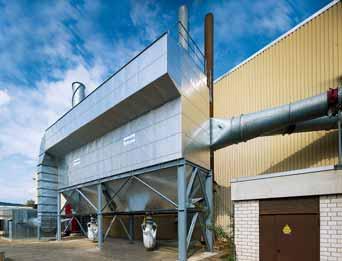
3 minute read
SECONDARY COLLECTION OF EXHAUST AIR IN THE METALS INDUSTRY
from Extraction hoods
by Scheuch

The production and processing of metals usually creates considerable amounts of exhaust air containing corresponding amounts of energy and pollutants. It is not possible to enclose or directly extract all of the processes and processing steps in this industrial sector. Instead of being collected directly where they occur, emissions (dust, waste heat, gasiform substances) must then be collected using secondary systems in order to achieve the desired air quality in the workplace area or in the affected surroundings. The associated attenuation of the emission stream determines the required collection stream and directly affects the capital investment and operating costs of the dedusting plant.
Advertisement
In actual practice, extraction systems are designed as far as possible in terms of targeted costs, but ventilation systems can only be used effectively and economically when there is sufficient knowledge of the respective emission sources and collection devices and when the ventilation system and equipment are harmonized as closely as possible, i.e., when they are designed, selected and dimensioned as an integrated system. We began a comprehensive R&D project in order to optimize the collection of secondary exhaust airflows and to also increase the efficiency of the overall dedusting plant.
Complex Challenge
As a rule, the problems already begin with the specification of the emission stream - especially in the case of “hot” emission sources. As of today, this area is still lacking in an established and practice-oriented foundation. In addition to the general characterization of the source (filling or transfer processes, charging of metal melts, exothermic reactions, etc.), concrete data about the flow [m3/s] and the associated temperature [°C] of the emission stream are ultimately required.
In the case of existing production facilities, it is possible to assess these main characteristics during a plant tour or inspection. During this process, we document an existing emission source using a series of measurements and observations. Temperatures, for example, can be determined indirectly (well-known tapping temperature of a cast steel ladle) or by measurement (thermography). We determine the emission flow rate using scaled video analysis or, if necessary, through the addition of smoke. However, it should be noted during this estimation process that the emission flow in the forming thermic current increases as a result of mixing with ambient air. Other influences include superimposed flow fields (wind in the case of outdoor installations, airflows resulting from ventilation systems within buildings) or the movement of cranes above the source or the presence of already existing collection devices.
In the case of new plants awaiting construction, it is of course not possible to wait for an onsite tour or inspection. In this case, it is necessary to make use of models and so-called analogy observations. However, because of the complex fluidic interactions, simplified approximation procedures developed in the 1950s for industrial ventilation and workplace hygiene applications can hardly be used to develop a concrete and authoritative technical design.
Today, computer-assisted modeling (CFD) gives us a tool that makes it possible to design an exhaust air collection system for hot emission sources also found in smaller projects. Naturally, this requires an appropriate level of experience with respect to specifying the boundary conditions of the computational model and a continuous comparison of the theoretical design with results obtained in actual practice.

The emission source is captured using video analysis and then characterized with respect to outgoing airflow, particle type and shape, and emission type.
CFD simulation of an extraction hood that must collect secondary/diffuse dust types when closed encapsulation is not possible.

For the respective task, Scheuch offers a methodical approach for creating a reproducible characterization of the emission stream (execution, documentation and analysis of plant inspections) and the development using CFD of an optimal concept for collection devices with consideration of the operational boundary conditions.
Dedusting Of Galvanizing Plants
Based in Kreuztal/Germany, Siegener Verzinkerei Holding GmbH (SVH) has invested in what is that country's largest galvanizing pot. Galvanizing of individual workpieces with lengths up 19.2 meters is now possible in a single immersion process.
During the hot-dip galvanizing process, the flux material reacts with the molten zinc. According to TA Luft regulations, the gasiform (HCl) and dusty emissions (zinc chloride/ammonia chloride) created by this process must not exceed 20 and 5 mg/m3, respectively. In order to comply with these emission limits, a special collection, extraction and dedusting system is required, dimensioned in this case for 100,000 m3/h.
The exhaust air is collected using an enclosure for which Scheuch has determined the required exhaust airflow as a function of the bath surface and the customer's product mix. An energy-saving control program regulates the performance of the dedusting plant as a function of the production parameters.
Scheuch - the specialist for industrial dedusting systems - delivered this plant, which began operating last year. In addition, other companies in this branch also use Scheuch technology at plants in Germany, Austria, Egypt, Saudi Arabia, the Czech Republic, Estonia, Azerbaijan, Holland and Russia.


